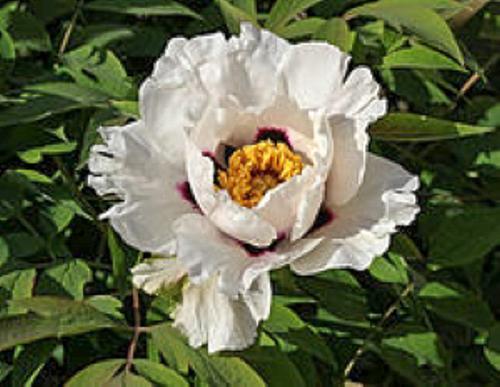SPRINGFORTH !
From June 2011 Tips and TalesShared by Charles Shank

Last fall, one of our new residents, Barbara Wheatley, was at a meeting of the Spotswood Garden Club in Harrisonburg. She bumped into Ron Brown, a local horticulturist who has many attributes, including an extensive woodland-type garden in Harrisonburg and involvement with the development of the arboretum at JMU. He has hundreds, if not thousands, of plants in his garden, including many tree peonies that he actively propagates.
In short, he offered to supply Sunnyside with a large number of tree peony plants...gratis! Barbara brought up this matter to a number of us and we decided to pursue it. We spontaneously formed a committee made up of some Sunnyside amateur gardeners that we happened to know. The members: Barbara Wheatley (chair), Charlie Campbell, Tip and Eugenia Parker, Jim and Kay Stilwell, Charley Shank and Widgee Zirkle. Since we were planning some possible new landscaping for Sunnyside that would be forthcoming in the spring, we named our new organization SPRINGFORTH.
The plan: We saw this as a most unusual opportunity to further enhance the Sunnyside landscape with a unique type of planting that would not ordinarily be available on the scale that we were being offered by Ron. It was envisioned to develop a number of fairly large planting beds. Not only would there be tree peonies; there would also be included a small number of other plants to add interest and variety.
To start with, the two areas mentioned above were decided upon for the initial planting because they have relatively high visibility and are close to where some of the SPRINGFORTH members live, which would allow for the new plants to be closely watched and cared for. Once tree peonies get established they are hearty plants that need little attention.
Next, the administration was approached. They approved the idea. Early this spring the beds were prepared by Sunnyside’s Buildings & Grounds Department. At the right time, as selected by Ron, members of SPRINGFORTH went to his garden and he dug the plants for us . . . about 75 of them. We brought them back to Sunnyside and planted them. Ron also gave us some hydrangeas that we included in the new beds.
So, now we have a couple of newly planted beds with some fairly scrawny looking plants that are trying to become established. The amount of rainfall so far has been very helpful. (Natural rainfall does so much better than watering.) Just after being planted, most of them looked pretty good. However, there has been some struggling. Some of them wilted . . . not exactly springing forth. They were given more water more often and they perked up. For a while there was off and on wilting and perking up. A few may be lost. Generally, it looks like almost all of them will probably make it, with some being diminutive. A lot of them really look great. And, some have blossomed! With time and care, they should become bushy, beautiful and a true pleasure for all.
Incidentally, to buy tree peonies you will find that they are expensive . . . ranging from $25.00 and up, per plant. It has been fun and rewarding for SPRINGFORTH to work with Sunnyside staff, Ron Brown and the tree peonies. So, let's all hope that the tree peonies thrive.
(Information about tree peonies from the web: "Few plants are revered like tree peonies. They originally came from China. It is the national flower of China and was once grown exclusively by the emperor. For centuries the blossoms of tree peonies have been called luminescent, silky, exotic, exquisite, and magnificent. The accolades continue today What is a tree peony? Tree peonies (Paeonia suffruiticosa) are actually shrubs, not trees. They produce woody stems and do not die back to the ground like herbaceous peonies, the common peony that we are most familiar with. They are fairly slow growing but long lived. Some specimens in China are thought to be more than 200 years old. They eventually grow to 3 to 5 feet tall. Tree peonies have larger flowers than herbaceous peonies and are available in a wider range of colors. Yellow, purple, maroon, and green are a few colors commonly available in tree peonies but rarely seen in herbaceous peonies. Both single and double flower forms are common. Many varieties of tree peonies have fragrant flowers or flowers with contrasting centers, adding to their appeal. Tree peonies bloom in the spring a couple of weeks earlier than herbaceous peonies. They have attractive foliage that is shed in the fall leaving also attractive, arching bare stems." -- Charley Shank)
(Ten years later, the tree peonies planted between the Vista Glen villas are still doing well, according to Kay Stilwell, one of the original SPRINGFORTH committee members mentioned in the story, who can see them outside her window. “They were just sticks when we planted them,” she said. But she said they haven’t required much maintenance once established. “They have a beautiful bloom in the spring, but it doesn’t last long.” This was the only project taken on by the committee, but it has had a long-lasting impact.)